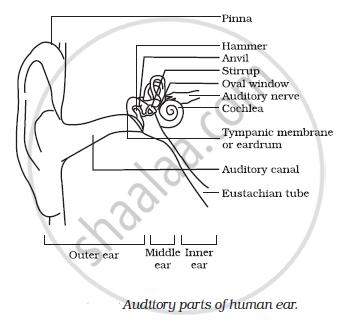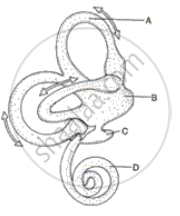Advertisements
Advertisements
प्रश्न
Explain how the human ear works.
उत्तर
Different sounds produced in our surroundings are collected by pinna that sends these sounds to the ear drum via the ear canal. The ear drum starts vibrating back and forth rapidly when the sound waves fall on it. The vibrating eardrum sets the small bone hammer into vibration. The vibrations are passed from the hammer to the second bone anvil, and finally to the third bone stirrup. The vibrating stirrup strikes on the membrane of the oval window and passes its vibration to the liquid in the cochlea. This produces electrical impulses in nerve cells. The auditory nerve carries these electrical impulses to the brain. These electrical impulses are interpreted by the brain as sound and we get a sensation of hearing.

APPEARS IN
संबंधित प्रश्न
Which part of our body helps us in maintaining the body balance?
the biological/technical terms for a thin membrane covering the entire front part of the eye.
Sclerotic layer or choroid layer.(Which one forms the Iris ?)
Differentiate between members of the following pair with reference to what is asked in bracket.
Dynamic balance and static balance (Definition)
Name that part of ear which vibrates when outside sound falls on it.
The diagram alongside represents the structure found in the inner ear. Study the same and then answer the questions that follow:
(i) Name the parts labelled A, B, C and D.
(ii) Name the parts of the ear responsible for transmitting impulses to the brain.
(iii) Name the part labelled above which is responsible for:
1. Static equilibrium. 2. Dynamic equilibrium. 3. Hearing
(iv) Name the audio receptor cells which pick up vibrations.
(v) Name the fluid present in the inner ear.

Choose the Odd One Out:
The hearing range of the human ear is ______.
The Eardrum moves inward when a rarefaction reaches it.
Given below is a diagrammatic representation of a part of the human ear.
- Name the parts numbered 1-6.
- Which parts of the ear shown here are complete.
 |
